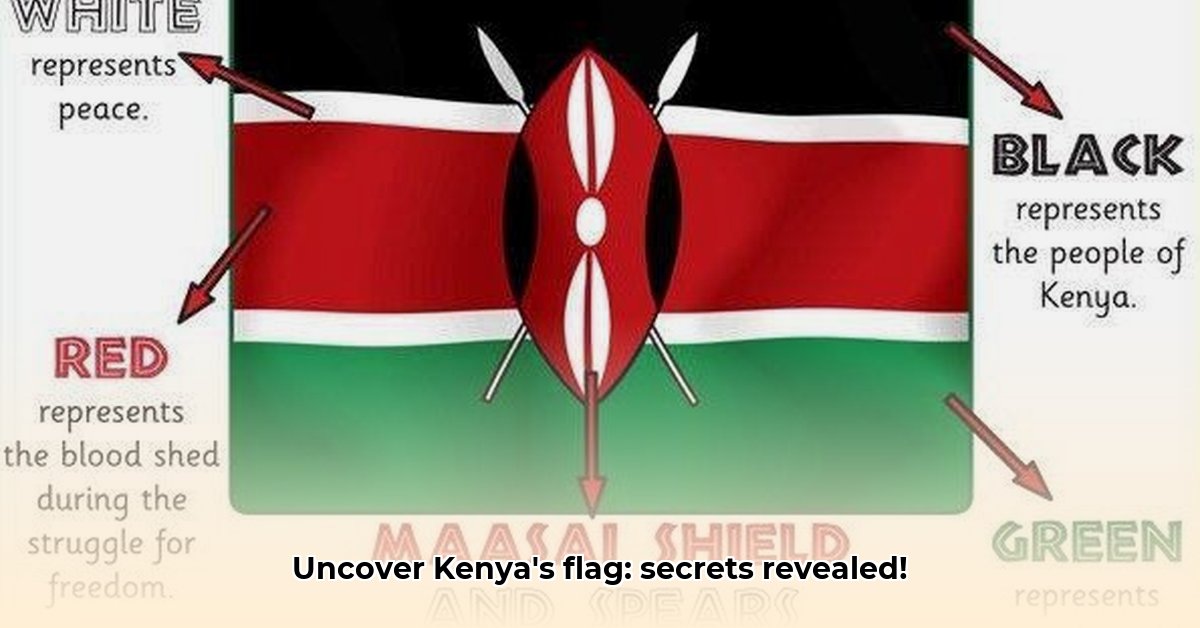
Kenyan Flag Symbolism and History
The Kenyan flag—a striking combination of black, red, and green stripes framed by white—is far more than a simple emblem. Adopted on December 12, 1963, the day Kenya achieved independence, it's a potent visual narrative encapsulating the nation's journey, struggles, and aspirations. Its symbolism resonates deeply within Kenyan society, uniting diverse communities under a shared banner. But what do these colors and the central imagery truly represent? For more details on Kenyan flag symbolism, see this helpful resource: Kenya flag details.
The deep black stripe powerfully symbolizes the Kenyan people—a diverse tapestry of ethnic groups and traditions woven together to form a single nation. This rich hue represents the collective strength and shared heritage that binds Kenyans together, despite their varied backgrounds. It's a reminder of the countless individuals who have contributed to Kenya's rich history.
The vibrant red stripe is a potent reminder of the sacrifices made during the arduous struggle for independence from colonial rule. This isn't merely a symbolic representation; it's a visceral acknowledgment of the bloodshed and hardship experienced by countless Kenyans in their fight for freedom. It speaks to the enduring resilience and determination of a people committed to self-governance. Did you know that the struggle for independence encompassed not just physical battles, but also profound social and political upheavals?
The lush green stripe embodies Kenya's fertile lands and abundant natural resources. It reflects the agricultural heart of the nation, the fertile lands that sustain its people, and the nation's potential for prosperity. This evocative green isn’t just about agriculture; it represents the vibrant ecosystem and the natural wealth of Kenya.
Finally, the slender white stripes act as a unifying frame, representing peace, unity, and harmony—a constant aspiration for a nation striving for cohesion amidst its diverse population. These serene white accents stand in contrast to the bolder colors, symbolizing the pursuit of peaceful coexistence and national unity. How effectively has this symbol of unity advanced national integration?
At the heart of the flag lies the potent imagery of a Masai shield and two crossed spears. This isn't mere decoration; it's a powerful symbol of defense, protection, and the enduring spirit of resistance. The choice of Masai imagery is particularly significant, reflecting the Maasai's renowned cultural heritage and their historical role in Kenya. However, this symbolism transcends tribal boundaries, representing the collective strength and determination of all Kenyans to protect their hard-won independence. The weaponry isn’t just a symbol of military might; it’s a representation of the unwavering commitment to national sovereignty.
"The inclusion of the Masai shield and spears speaks volumes about the nation's appreciation for its indigenous heritage and the strategic use of cultural symbolism to promote national unity," says Dr. Anika Njeri, Professor of History at the University of Nairobi.
Beyond the readily apparent symbolism, deeper interpretations exist. Some historians highlight the black stripe as representing indigenous populations and their ancestral connection to the land. Others view the intensity of the red as reflecting the brutality of the fight for freedom. The shield and spears, while linked to Maasai culture, also evoke the warrior spirit and resistance found across many Kenyan communities throughout history.
The Kenyan flag’s symbolism is not static; it’s a dynamic entity, evolving with the nation's identity. Its meaning continues to change and develop, shaped by experiences and aspirations. This ongoing evolution enriches our understanding of national identity and the enduring power of symbols. "The flag's continued relevance highlights its ability to adapt to changing times while remaining firmly grounded in its historical context," notes Professor Njeri.
Key Takeaways:
- The Kenyan flag's vibrant colors symbolize the people, the sacrifices for freedom, and the nation's natural resources.
- The Masai shield and spears represent Kenya's resilience and defense of its sovereignty.
- The flag's symbolism is dynamic, reflecting Kenya's evolving national identity.
How Did the Maasai Shield and Spears Influence Kenyan Flag Design?
The Kenyan flag’s design is not simply a matter of aesthetics; it's a product of political compromise, cultural representation, and historical context. Understanding its creation is key to appreciating the depth of its symbolism. The process of adopting this design reflected the complex negotiations involved in forging a unified national identity after independence.
The flag’s tri-color design—black, red, and green—itself represents a compromise between competing political factions, each with their own proposed flag designs. The final design is a testament to the desire for national unity, transcending the divisions of the past. This wasn't mere happenstance; it reveals the significance of compromise in building a national identity.
The colors themselves carry profound meaning. Black, as mentioned earlier, represents the Kenyan people, their unified identity, and their shared history. This is not merely a representation of color. It is a historical symbol, reflecting the shared culture of the many different tribes of Kenya. Red symbolizes the sacrifices made during the struggle for independence, the blood spilled in pursuit of freedom. Green represents the nation's fertile land and its agricultural bounty, a symbol of prosperity and potential. The white borders, in contrast, symbolize peace and national harmony.
The inclusion of the Masai shield and spears is a strategic move—a visible acknowledgment of the Maasai's rich cultural heritage and their role in Kenya's history. These elements embody resilience, defense, and the protection of sovereignty. However, this imagery extends beyond the Maasai community, representing the collective strength and determination of all Kenyans in safeguarding their nation’s independence. This is a powerful symbol of unity, celebrating the diverse cultures that shaped Kenya. It's not just about the Maasai; it's about a shared national sense of identity.
The flag’s design, therefore, wasn't accidental. It was a carefully considered amalgamation of color, symbolism, and political compromise, designed to unite a diverse nation under a single, powerful banner. The flag's enduring resonance speaks to the success of this carefully orchestrated design.